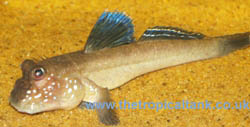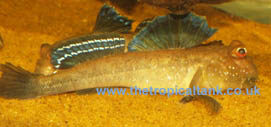|
|
African Mudskipper


Photos © Sean Evans
|
| Common name: | African Mudskipper, Atlantic Mudskipper |
| Scientific name: | Periophthalmus barbarus |
| Synonyms: | Periophthalmus papilio |
| Size: | 8" (20cm). |
| Origin: | Widely distributed along West African coast. |
| Tank setup: | A large brackish water tank with a beach/land area is required. Due to their aggressive
and territorial behaviour, a tank of at least 60 x 18" (153 x 46cm) base area is recommended, with rocks and wood to break up the line of sight.
A tight-fitting cover should be used, both to prevent escapes and keep the humidity high on the land areas. |
| Compatibility: | Territorial and often highly agressive with their own kind, which can result in
injury and death of weaker individuals. |
| Temperature: | 25-29oC (77-84oF) |
| Water chemistry: | Brackish water with an alkaline pH. Tolerant of a wide range of salinity, from freshwater to
full marine conditions. However, medium brackish water (approx sg 1.010) is probably ideal, and some variation in salinity may be beneficial. |
| Feeding: | Omnivorous: feeds on insects, molluscs and crustaceans and some vegetable matter. Frozen foods such as bloodworm,
krill, mussel and prawn can be used. Sinking pellets are also usually eaten and can be used to vary the diet. Insects can be introduced onto the land area, to stimulate a natural
feeding behaviour. If crickets are used, they should not be too large or fed too regularly, as there may be a risk of impaction (digestion problems). |
| Sexing: | Males possess a larger dorsal fin. |
| Breeding: | Spawns in burrows. Not reported in captivity. |
| Comments: |
This is probably the most commonly imported mudskipper in most countries, but its aquarium maintenance can present problems due to extreme aggression. It may therefore be advisable
to keep a single specimen in most cases. If a group is kept, the aquarium needs to be large, with plenty of space broken up with decor. Even then, injuries are likely and weaker
individuals may be killed. A more suitable mudskipper, particularly for the less experienced fishkeeper, is the smaller Indian Mudskipper.
|
[Home]
[Article Library]
[Fish Index]
[Tank Setups]
[Forum]
[Site Map]
|
|
|





